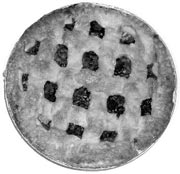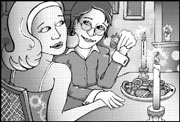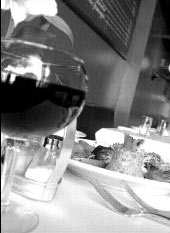PIE IS THE MOST evocative of desserts. Say “cake,” and one thinks “birthday”; say “pie,” and one immediately drowns in memories of family holidays—stealing nibbles of crust while deluding yourself no one is noticing, fighting your sibling for those cinnamony little treats made from the leftover dough, innocently believing that all families have five pies to distribute among four family members like yours does (OK, maybe just mine). Ahh, pie.
There is no surer method of curing holiday blues than curling up solo with an entire pumpkin pie, a pint of whipped cream, and a fork. Sadly, pie is not a dessert that translates well to commercial production, and it doesn’t make much difference whether you spring for a $20 bakery special or raid the 3-for-$5 stacks in the frozen grocery case. Yet many of us have a deep-seated fear of attempting to construct this beloved confection from scratch.
We’ve all encountered folks who swear that you must have a knack for pie or it’s hopeless, or that a proper piecrust is even more difficult to create than one of those vertical desserts in a spun-sugar cage. You may have even admitted defeat and purchased a pan of gluey sand labeled “frozen deep-dish piecrust,” or succumbed to the giggling siren song of Mr. Doughboy and tried his refrigerated blankets of salty paste. In light of these half-baked travesties, Marie Callender’s starts to look pretty tasty after all.
But honestly, how hard can something with four ingredients be to make? Everyone can have a “knack” with a wee bit of practice and a secret tool that grandma never told you about, as it would’ve blown the whole “knack” bit straight to hell. First, get online at www.pierecipe. com or crack open that long-ignored cookbook that you were given when you rented your first apartment. Pie is ubiquitous enough in American cuisine that unless your book is titled Unpleasantly Obscure and Low-Fat Recipes That No One Likes, you are sure to find a basic crust recipe. Read through it once, just to make sure you’ve got the requirements—fat of some prepackaged sort, water, flour, and salt. Chill the fat and the water, and then run out to the kitchen shop when you realize you can’t find the mixing bowl presented at the same time as that old cookbook. Feel slightly ashamed that all you ever eat is take out, but make stern promises to yourself that Next Year Will Be Different.
WHILE YOU ARE at the kitchen shop, shell out an extra $5 for the top-secret tool. This is nothing more than a heavy canvas sheet known as a pastry cloth, which is used in conjunction with a knitted tube that slides over a rolling pin or pinch-hitting wine bottle, much like a terry-cloth condom. Together, these two items prevent your crust from sticking to the counter, the pin, and your fingers. Many folks use flour to free the crust from the countertop, but this all too easily results in an overly floured crust that is dry, tough, and tasteless.
The cloth and the tube are infinitely reusable, and over time will absorb extra flour from the crusts to make the rolling process utterly painless. As an extra bonus, some pin covers are textured and leave the crust looking a bit like your favorite sweater. Obviously, this can add all sorts of new decorating possibilities to pies with a top crust (when you reach that exalted plane). Whipped cream zippers? Collars and pockets outlined in egg glaze? Gumdrop buttons?
Return home from the shop, feeling victorious. Measure the flour and salt into your lovely new mixing bowl and remove the fat and water from the fridge. Cut the fat into small pieces and sprinkle over the flour. Wash your hands (please!), and then plunge them thrillingly into the bowl to do what you were never allowed to do—play with your food. You should mix the fat into the flour thoroughly, but not to the extent that you manage to form anything resembling dough. It should be mealy, with small, distinct bits of flour clinging to each other. Books often refer to pieces the size of peas, but try for the size of lentils. Add the cold water a spoonful at a time, mixing well with a large spoon.
Depending on the size of the recipe you’re working with, at some point you’ll end up with a relatively solid lump in the bowl, with a distressing amount of loose flour still clinging to the bottom. Ignore the lost bits, and proceed to roll out your trophy using your exciting new tools. If at this point you realize you forgot to purchase a pie pan, don’t fret. Just fold your crust up in some plastic wrap and slide it into the fridge while you run off to the store again. Hopefully, you are better prepared than that and can proceed with lining the pan with the crust, pouring in your pumpkin filling (just do what the can’s label tells you to do—it’s brainless and perfectly fine tasting), and sliding the pie into the oven for an hour or so.
Now would be the perfect time to turn the ringer off, crank up the heat, and dream of the days when you can bore future generations with tales of pie. Ahh, pie.
The secret, weird pastry cloth/pin cover sets are available at Sur la Table (84 Pine , 448-2244, and 90 Central Way, Kirkland, 425-827-1311, and www.surlatable.com) and at www.rollingpin.com (yes, for real!).








